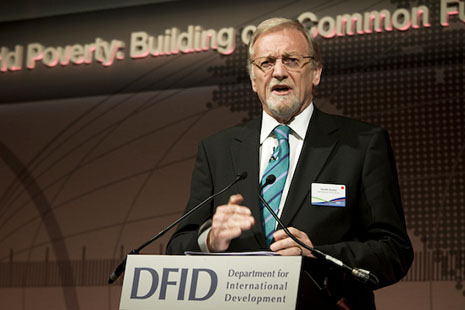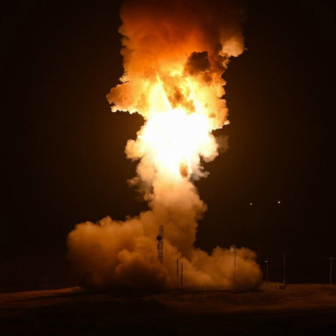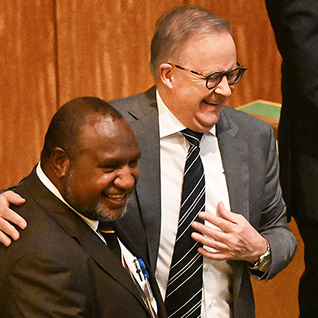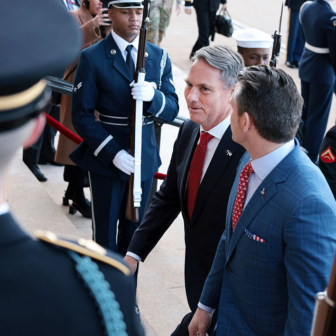AN EMINENT international think tank has issued a grim new warning about the potential threat posed by more than 20,500 nuclear weapons still held by eight nations headed by the United States and Russia. The 2011 yearbook of the Stockholm International Peace Research Institute, or SIPRI, highlights the apparent determination of the United States and Russia to retain their nuclear arsenals and efforts by India and Pakistan to develop new ballistic and cruise missiles and to produce fissile material for military use.
SIPRI’s concerns are supported by numbers. There are still more than 5000 deployed nuclear warheads, overwhelmingly Russian and American, among the 20,500 warheads still in existence, and India and Pakistan are engaged in a nuclear weapons arms race to increase their current arsenals of around one hundred warheads each. The prospect of total nuclear war between the superpowers may have diminished since the end of the Cold War, but it has obviously not been eliminated. Now, alarmingly, Islamist terror groups are actively seeking access to nuclear weapons – and only a fool would bet on the security of Pakistani warheads.
World nuclear forces, 2011
| Country | Deployed warheads* |
Other warheads |
Total 2011 |
Total 2010 |
| US | 2150 | 6350 | 8500 | 9600 |
| Russia | 2427 | 8570 | 11000 | 12000 |
| UK | 160 | 65 | 225 | 225 |
| France | 290 | 10 | 300 | 300 |
| China | 200 | 240 | 240 | |
| India | 80–100 | 80–110 | 60-80 | |
| Pakistan | 90–110 | 90–110 | 70-90 | |
| Israel | 80 | 80 | 80 | |
| Total | 5027 | 15500 | 20530 | 22600 |
Source: SIPRI Yearbook 2011. Some figures are rounded.
* “Deployed” means warheads placed on missiles or located on bases with operational forces.
But while nuclear weapons are rightly the primary focus of international disarmament efforts, they are not the only sword of Damocles suspended over the heads of humanity. Much less openly discussed threats from biological weapons may be no less dangerous. For terror groups biological weapons may be a simple and devastating alternative to nuclear weapons.
It was one of the oddities of the end of the Cold War that while US and Soviet leaders wrestled openly over reducting their then-vast nuclear arsenals of more than 60,000 warheads there was little open discussion of the enormous Soviet biological weapons program, conducted in violation of the 1972 Biological Weapons Convention. The disturbing story is told in David Hoffman’s 2009 Pulitzer Prize-winning book, The Dead Hand. His argument, in brief, is that American leaders did not push the Russians publicly over the biological weapons program because they wanted to maintain the momentum of nuclear weapons negotiations, and Russian leaders would not come clean about the program because they did not want to acknowledge that they could not control the generals and scientists in charge of germ warfare.
The historic summit meetings between Presidents Reagan and Bush and Mikhail Gorbachev and Boris Yeltsin, and other top-level meetings that accompanied the collapse of the Soviet empire and the end of the Cold War, had some success in helping to reduce US and Soviet nuclear weapons stockpiles from their 1989 total of 61,380. But the Soviets would not unveil their biological weapons program, even when it became known that between sixty-five and 105 people had been killed in 1979 when anthrax spores escaped into the atmosphere at a biological warfare laboratory near the Russian city of Sverdlovsk. The programs continued unabated.
As Hoffman reveals, it was not until 1992 that Yeltsin, in an aside during an interview with a Russian newspaper, acknowledged the Sverdlovsk anthrax outbreak and attributed it to “our military development.” Later, in an address to the US Congress, he promised “no more lies,” but, Hoffman notes, “the deception went on.”
In a chilling epilogue reflecting on the efforts of terrorists to acquire nuclear and biological weapons, Hoffman writes: “It is difficult to build a working nuclear bomb, but less difficult to cultivate pathogens in a laboratory… Today one can threaten a whole society with a flask carrying pathogens created in a fermenter in a hidden garage – and without a detectable signature.”
In fact there has been little progress in recent years towards the elimination of either nuclear or biological weapons. As SIPRI deputy director Daniel Nord says, “The nuclear weapons states are modernising and are investing in their nuclear weapons establishments. So it seems unlikely that there will be any real nuclear weapons disarmament within the foreseeable future.” The 2010 Strategic Arms Limitation Treaty, or START, signed by President Obama and Russian President Medvedev, will modestly cut strategic nuclear forces but, as the SIPRI annual report says, the two countries “appear determined to retain their nuclear arsenals for the indefinite future.”
Certainly there has been no serious move by either side to revive the proposals that surfaced at the 1986 Reagan–Gorbachev summit at Reykjavik, when the two leaders discussed cutting warheads by 50 per cent and eventually eliminating them entirely. The meeting broke down over Reagan’s refusal to limit “Star Wars” research to laboratory experiments, but the meeting gave the leaders a momentary glimpse of a nuclear-free future.
It may be that nuclear weapons attract most attention these days not just because they can destroy nations as functioning modern entities but also because they are easier than biological weapons to identify, count and quantify. Biological weapons may, however, be the greater peril to mass populations. They can easily be made portable, and genetically engineered pathogens can quickly produce devastating casualties in large urban areas. As Hoffman notes, Russian institutes once involved in germ warfare remain closed to Western cooperation. “What is behind the closed doors?” he asks. “And most importantly, what has become of the scientists with know-how to create pathogens that can be carried in a shirt pocket? What are they working on today?”
SIPRI is one of several international bodies pushing for the elimination of nuclear weapons. Others include the Australia–Japan International Commission on Nuclear Non-Proliferation and Disarmament and the recently established Centre for Nuclear Non-Proliferation and Disarmament at the Australian National University in Canberra. Credit for the establishment of these organisations is due primarily to former Labor foreign affairs minister, Gareth Evans, now chancellor of ANU. Evans has for many years been obsessed (some would say magnificently obsessed) with nuclear weapons elimination. In 1995 he set up the Canberra Commission on the Elimination of Nuclear Weapons, but the election of a Coalition government eventually ensured its report received only token support.
The Canberra Commission’s report anticipated by twelve years the appeal by four US Cold War elder statesmen for the elimination of nuclear weapons. In late 2007, Henry Kissinger, George Shultz, William Perry and Sam Nunn made international headlines when they urged the elimination of nuclear weapons in terms little different from those of the commission. In 2009 in Prague President Obama pledged to cut nuclear weapons stockpiles, saying they were a dangerous Cold War legacy.
But words are cheap and progress is glacial – and biological weapons, also a Cold War legacy, have received nothing like the detailed attention devoted to nuclear arsenals. The Australia–Japan commission, and the new ANU centre, would enhance the value of their work by alerting policy-makers to the issues surrounding elimination of biological as well as nuclear weapons. They might start by seeking answers to Hoffman’s questions. •




